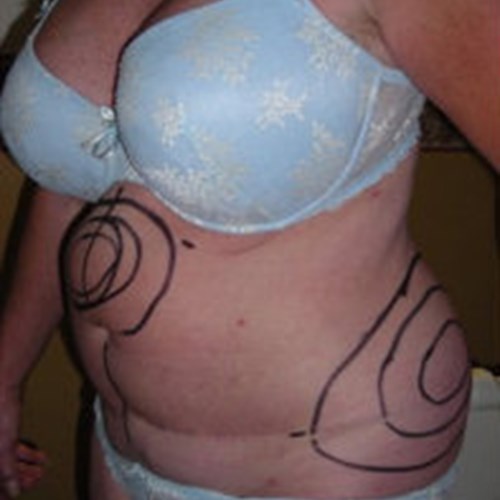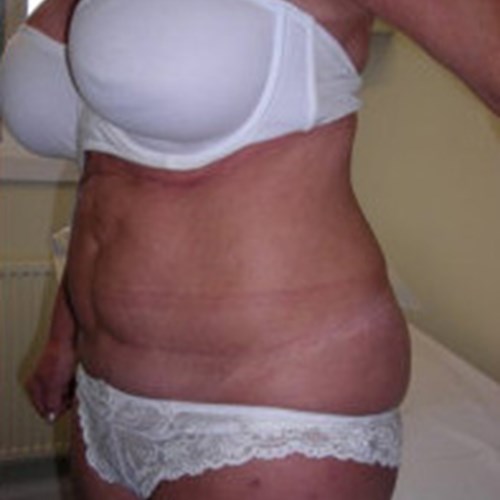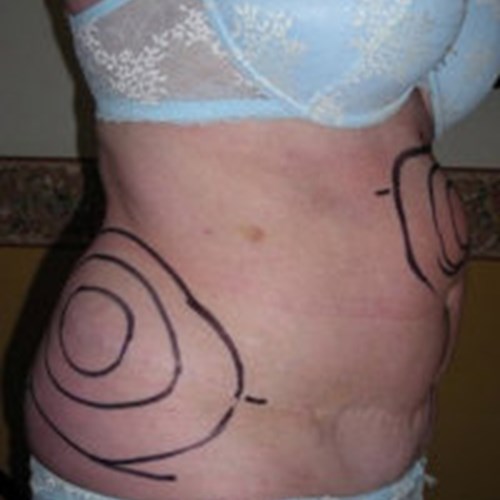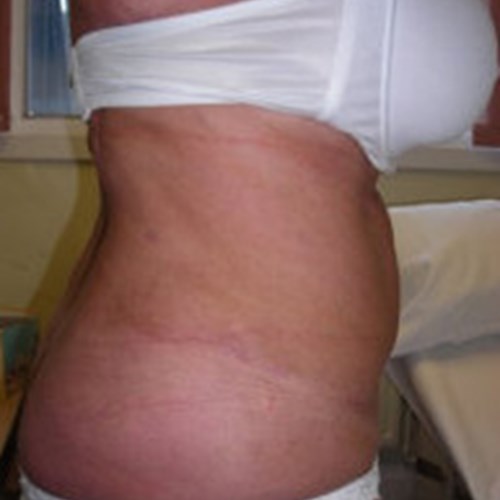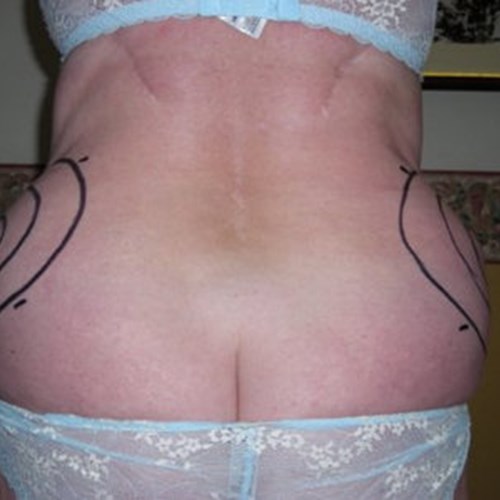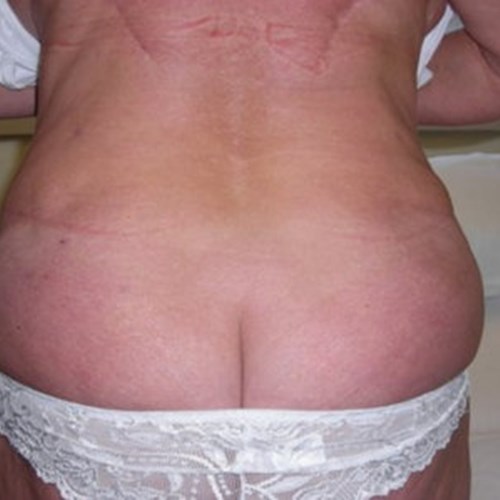The procedure is best suited to healthy individuals who are at, or close to their ideal weight for height, and who have good quality, elastic skin. Although liposuction can tighten skin to a degree, it will not correct gross skin excesses. In this regard, young patients fair better than older patients. Patients with more skin than fat excess usually require an excisional procedure (dermolipectomy), such as a thigh lift or tummy tuck to remove the excess skin.
Common areas treated with liposuction in women include the thighs, hips, buttocks and tummy. The saddlebag area, the love handles and the tummy all respond well to liposuction. Although the inner thighs do not respond as well, some improvement can still be achieved here. Other areas which can be treated include the knees, calves, ankles, breasts, arms and neck. Liposuction may be used as an adjunct at the time of breast reduction surgery. Liposuction is particularly useful for a fatty neck and it is often used at the time of facial rejuvenation (face-lift surgery). In men, the common areas treated with liposuction are the chest, tummy, love handles and neck.
Prior to Surgery
If you are considering liposuction, consider what you want and which areas you regard as problematic. Think of any questions you may have and write them down to ask me later.
No patient is operated on without a formal face-to-face consultation. At this consultation your suitability and fitness for the procedure will be assessed. You will be examined and routine pre-operative photographs will be taken. Surgical options are discussed, as well as the risks and complications, venue for surgery and type of anaesthesia to be used.
Prior to surgery you will need to acquire one or two pressure garments to be ready to be worn after surgery. Elasticized cycling shorts are good for buttocks or thighs.
If you are a smoker, you should try to stop smoking 1 week before surgery and avoid smoking till healing is complete. If you are on any medication, inform your surgeon (this includes the oral contraceptive pill). Avoid aspirin containing drugs before and after surgery. Arnica, a homeopathic remedy, may help to diminish bruising and swelling in the area, but it should only be started on the second postoperative day, as it can increase the risk of bleeding if taken early. It is available from health shops. No specific diet or exercise program is required prior to surgery although the closer you are to your ideal weight, the more satisfactory the outcome is likely to be.
Prior to surgery arrange to have plenty of clean linen and towels - some fluid tends to leak out post-operatively and you may need to change soiled linen. Also ensure that you arrange for someone to drive you home from the hospital and to look after you on your first post-operative night. Make sure that for a few days after the surgery you have as few commitments as possible so that you can recuperate in peace.
Drink plenty of fluids the day before surgery, and in the post operative period.
Hygiene is obviously important and you should shower on the morning of surgery, and every day after the operation too.
On the day of surgery you should be fit and healthy. You should not be suffering from a cold, flu or any other illness. If you think you might be anxious the night before surgery, or if you want something to help you sleep, ask for this beforehand and it will be prescribed.
Surgery
I perform many localised liposuctions as day case surgery under local anaesthesia although hospital admission and an overnight stay can be arranged if indicated or preferred.
Prior to surgery, oral sedation/pre-med may be given if desired and the area(s) to be treated will be marked. You will be taken through to the operating theatre, the area to be liposucked will be prepared with a sterilizing solution to clean the skin and then the area is draped with sterile towels. I use the tumescent technique: a large volume of local anaesthesia is infused to prevent intra and postoperative pain and to reduce bleeding.
The actual liposuction is performed through small (about 5 mm) incisions, usually made in well hidden areas such as the panty line or in natural creases, for example, the lower buttock crease. A tube, called a cannula is inserted and the fat is sucked out. When the aspirate becomes bloody and the final desired contour is reached, suction is stopped. Each incision is closed with a single suture and dressed with a light dressing. The pressure garment is applied and you are transferred to the post-op recovery area (usually for a cup of tea and a biscuit!)
Following Surgery – Recovery
Most patients have their procedure performed as day cases and will require a responsible adult to drive them home and look after them on the night of surgery.
You should wake up almost pain-free and will be given painkillers to control any discomfort over the next few days.
You should drink plenty of fluids and pass lots of urine for the first 24-48 hours following surgery. Also, although you should rest up, you should try to mobilise: in other words, sit in a chair or walk around a little. This not only helps to mobilise fluid and thus reduce discomfort in the areas treated, but also prevents the development of leg clots.
Some blood stained fluid may leak through your dressings. You should plan ahead and have some towels and spare linen.
It is advisable for the pressure dressing to be worn continuously for three weeks, then just in the daytime for a further three weeks. It will help you conform to your new shape and keep swelling and bruising to a minimum. Arnica, started on day 2 after surgery, will also help with the bruising and swelling.
Do not expect to look or feel good immediately after surgery. Because of the fluid injected and fluid retention, you will actually be heavier following the liposuction. The areas treated will be swollen and a little sore - a bit like if you have worked out too hard in the gym. It is not unusual to feel depressed in the days or weeks following surgery. Try to keep in mind that this is normal and will subside as you begin to look and feel better.
The wounds take about 5-7 days to heal, although they will mature over the next year. The stitches placed are usually dissolvable. Bruising subsides quickly from day 2 or 3 following surgery and is usually mostly gone by 10-14 days after your op, although some degree can persist for 3 weeks after surgery. Swelling follows a similar but slower course and can even persist for a few months. Healing is a gradual process, which varies from individual to individual.
Depending on the degree of liposuction you have and the job you do, you should be able to return to work after 2-3 days. Different people respond differently and some patients take longer than this, even up to 2 weeks. Plan to keep things quiet during this time.
Patients who come from abroad require at least 7-10 days before returning home.
Stretching and bending exercises can be started at the end of the first week following surgery, but more strenuous activity should be avoided for two weeks after surgery. Again, people are different and when you resume activity depends on the extent of your procedure and how you feel.
Risks and complications
If performed by a Plastic Surgeon in a proper operating theatre under sterile conditions on a relatively fit and healthy patient, liposuction is a safe procedure. Major problems such as kidney failure, leg clots which migrate to the lungs, fat emboli and damage to underlying structures are possible, but very rare.
The commonest complications are minor persistent swelling and bruising and some degree of sensory change such as pins and needles or numbness. This is usually transient and resolves in a few weeks.
Contour irregularities are also relatively common and include bulges, dimples, furrows, steps, etc. Excess fat or too little fat may be removed. The skin may not re-drape tightly enough to the new shape. Cellulite is not improved by liposuction.
Pigmentary problems can occur especially if you go in the sun while still bruised. Sun exposure can fix the pigment in the skin and is to be avoided.
Most patients form inconspicuous scars. Red, raised, hypertrophic or keloid scars can occur, but rarely.
In general complications are rare, especially the major complications. Liposuction is one of the safest procedures performed on a daily basis by plastic surgeons.
Will the new shape last?
Suction-assisted lipectomy is a highly effective technique for giving you a new body contour with very little scarring. The fat which has been removed from you body at the time of liposuction is permanently removed. If you maintain a healthy lifestyle following the surgery and your weight remains constant, your shape should remain the same, the bulges should not reappear and you should be satisfied with the procedure. Up to 10-15% of patients elect to have a second procedure to remove more fat or to have some further shaping done.
Most patients are satisfied with the results of their liposuction – they feel more at ease with their bodies and more comfortable in a wide variety of clothes. As long as your expectations are realistic, you should be happy with your new shape. Liposuction is one of the best cosmetic procedures. The effects are long lasting, the scars minimal and the complications rare.
If you are worried post-operatively
Telephone the ward of the hospital from which you have been discharged.
Telephone my secretary Angie Harrison during office hours – 07961221874
In an emergency (and you have failed to contact me by the above two methods) then please telephone St George’s Hospital (020 8672 1255) and ask them to either bleep me or the Resident Plastic Surgery doctor on call (Bleep 7050).
